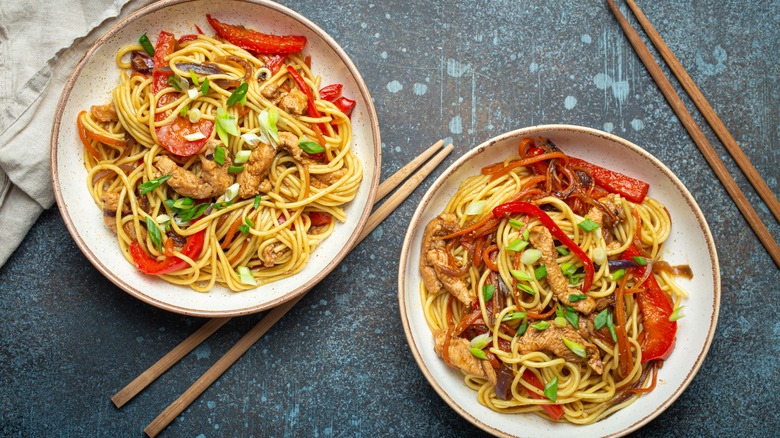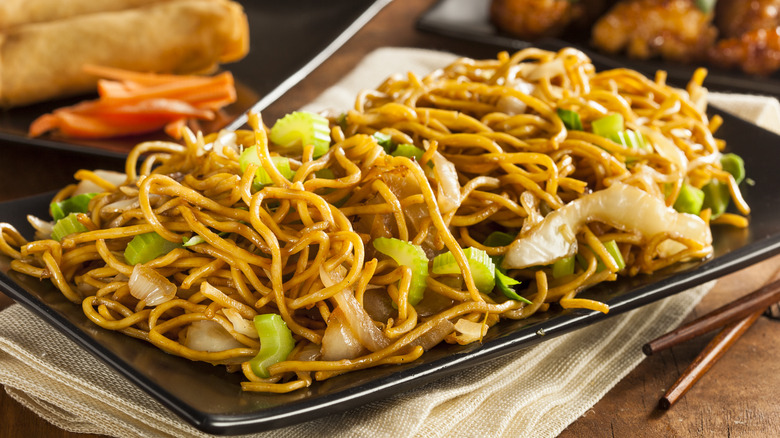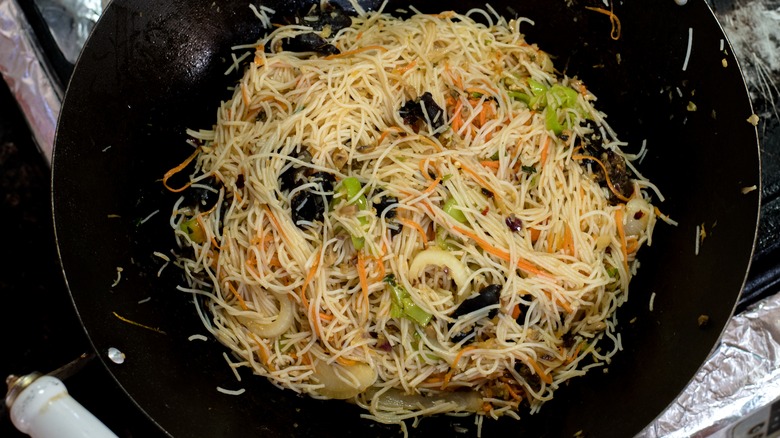Chow Mein Vs Lo Mein: What's The Difference Between The 2 Noodle Dishes?
The main difference between chow mein and lo mein seems like it should be right there in the name, at least if you're fluent in Cantonese. Chow is an English transliteration for a term meaning "pan-fried" (or simply "fried"), while lo means "stirred" or "tossed." Using the process of elimination, we can cleverly deduce that mein means "noodles." Unfortunately, the names alone don't tell us a lot, since you could be stirring the noodles as you pan-fry them, while the stirred noodles are likely to be cooked in a pan. Instead, one of the main differences between the two dishes, although undisclosed in their respective monikers, may lie in the sauce.
Lo mein tends to be made with a lot of sauce, and this sauce often includes cornstarch as a thickener. The sauce used in chow mein, on the other hand, is usually thinner and lighter. One version of the dish is called supreme soy sauce chow mein because it's meant to emphasize the condiment. This means it's made without meat and is light on vegetables, so the sauce doesn't have much competition from other ingredients. Other chow meins are made with no sauce at all, with dry-fried noodles that cook up much crispier than the ones in a saucy lo mein.
Chow mein comes in numerous varieties
A Cantonese-style chow mein may start with a very specific type of noodle. While lo mein and chow mein both include egg noodles, chow mein noodles are thinner and don't contain as much egg. They're available in either fresh or dried versions, with the latter needing to be steamed or boiled before they're pan-fried. While chow mein's meat and vegetable components may be minimal, such inclusions, if present, are cooked in the pan alongside the noodles.
Chow mein has spawned a number of New World descendants. In El Salvador and Guatemala, it may be made with carrots, celery, mushrooms, squash, and shredded pre-cooked chicken, while in Newfoundland, shredded cabbage stands in for the noodles. This "mein"-less chow mein wasn't created to cut back on carbs, but was necessitated by a lack of proper noodles back in the day. In Massachusetts, chow mein may come with a dinner roll or even as a sandwich, while Minnesota chow mein has a starch-thickened sauce sweetened with molasses. Canned American chow mein, too, may use starch in the sauce, while canned chow mein noodles are fried to the point of being crunchy and can be used as an ingredient in no-bake cookies and candies.
Restaurant-quality lo mein requires a little wok magic
Lo mein starts out as a standard stir-fry, with meat and vegetables cooked in a flavorful sauce. The noodles are cooked separately, drained, and stirred into the pan to spend a few minutes simmering with the other ingredients. This not only re-heats them, but allows them to absorb some of the flavor and color from the sauce.
Some chefs speak of something called wok hei, which roughly translates to "the breath of the wok." This cooking mojo doesn't apply to lo mein alone, but it's one of the dishes that benefit from that je ne sais quoi that can only result from high-level wok skills. It also helps to have access to a restaurant kitchen, but J. Kenji López-Alt thinks he may have cracked the code for home cooks. Wok hei results from the synergy of a well-seasoned carbon steel wok and super-high temperature, a heat that home ranges simply don't put out. As López-Alt writes in The New York Times, he's able to replicate it by pointing a propane torch at the lo mein to create that smoky wok hei flavor.
If this sounds a bit too hazardous for you, you can still get a tiny puff of wok breath by finishing your lo mein with some soy sauce drizzled around the outside of the pan, per López-Alt. This technique allows the sauce to develop a little of that restaurant-seared flavor.


